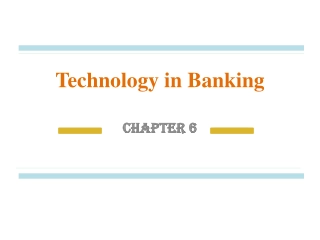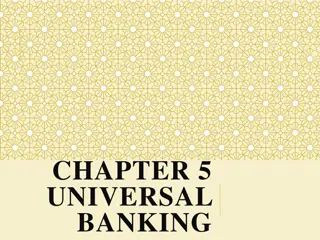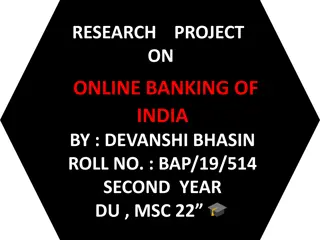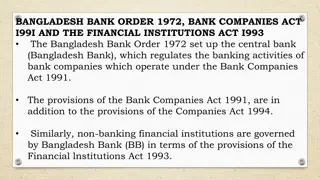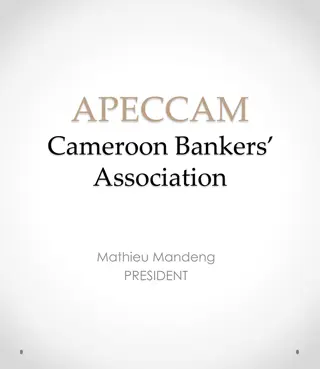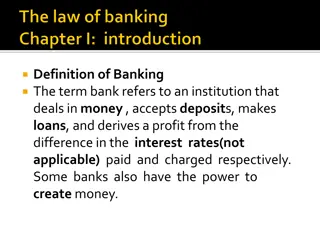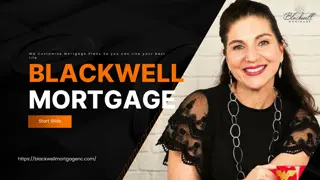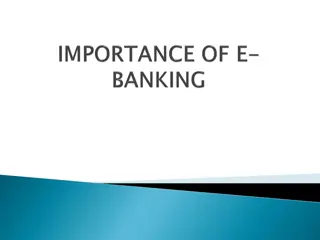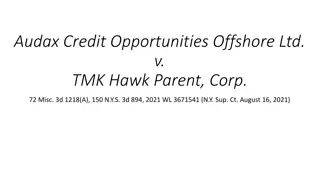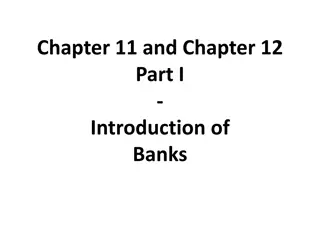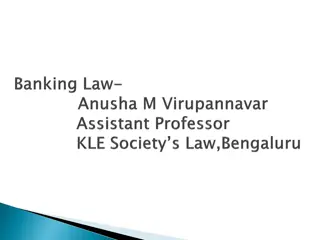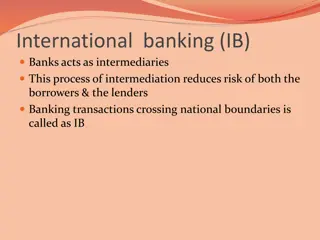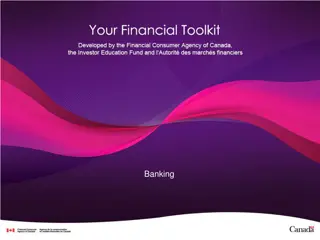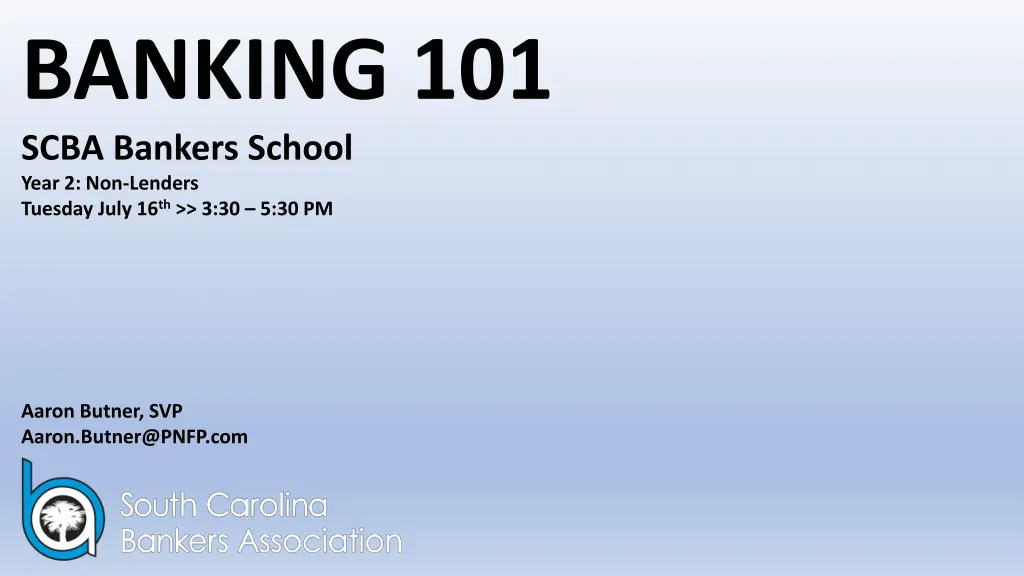
Banking 101 SCBA Bankers School Overview Session
Explore the high-level overview of banking, discuss the Banking Formula, and understand how psychology impacts financial institutions in this informative session led by Aaron Butner. Discover the general purpose of banking and the influence of your role within the bank.
Download Presentation

Please find below an Image/Link to download the presentation.
The content on the website is provided AS IS for your information and personal use only. It may not be sold, licensed, or shared on other websites without obtaining consent from the author. If you encounter any issues during the download, it is possible that the publisher has removed the file from their server.
You are allowed to download the files provided on this website for personal or commercial use, subject to the condition that they are used lawfully. All files are the property of their respective owners.
The content on the website is provided AS IS for your information and personal use only. It may not be sold, licensed, or shared on other websites without obtaining consent from the author.
E N D
Presentation Transcript
BANKING 101 SCBA Bankers School Year 2: Non-Lenders Tuesday July 16th >> 3:30 5:30 PM Aaron Butner, SVP Aaron.Butner@PNFP.com
DISCLAIMER This course is intended to be a high-level overview of banking. The goal isn t to necessarily teach bankers banking in this course. The aim is to help you understand the general purpose of banking and how your role affects others within your financial institution.
What do we want to accomplish during this session? To give a high-level overview of banking. To explore & discuss the Banking Formula . To better understand how psychology impacts your financial institution and how your role affects others within the bank.
Aaron Butner Who is this guy? Husband to Sarah. Daddy to Addi, Millie, and Maggie. In Banking since 2001. Fun Butner Family Facts: I have chickens! We love our feather babies! We love vacationing in West Jefferson, NC We are simple folk! I love changing lives through finance because a Bank Manager in Durham, NC changed MY LIFE! (Along with many others!)
What do we want to accomplish during this session? To give a high-level overview of banking. To explore & discuss the Banking Formula . To better understand how psychology impacts your financial institution and how your role affects others within the bank.
DISCLAIMER This course is intended to be a high-level overview of banking. The goal isn t to necessarily teach bankers banking in this course. The aim is to help you understand the general purpose of banking and how your role affects others within your financial institution.
What do we want to accomplish during this session? To give a high-level overview of banking. To explore & discuss the Banking Formula . To better understand how psychology impacts your financial institution and how your role affects others within the bank.
Where did banking come from? HISTORY 2000 BCE First documented evidence of lending activity in Mesopotamia. Temples were safe places to store valuable items, document the transaction, and lend out grain & seeds. 600 BCE The first standardized coinage system begins in the Greek city-state of Athens. The Roman Empire continued this through the 5th century. 14th & 15th Centuries The Medici family of Florence (not SC, y all), established the Medici Bank created some accounting practices that continue now! 1609 The birth of modern banking is credited to the founding of the Bank of Amsterdam. It functioned as a central bank and served as a model for the Bank of England (1694). 1840 s The invention of the telegraph allowed for faster communication between banks. 1870 s Innovation continues to pick up speed; the first wire is done by Western Union during the late 1800 s! 1913 The Federal Reserve System is established in order to help maintain stability & act as the central banking authority in the US.
Why is banking important? The purpose of a bank is to produce a profit by assisting customers, both businesses & consumers, with their financial needs including loans, the safe keeping of deposits, and to provide other financial ancillary services. A successful bank will generate revenue by creating good loans, prudently priced deposits, & consistent fee income. An enduring & long-lasting, profitable bank is one that operates with employees who practice balanced teamwork, caring collaboration, and execute on effective communication.
Since 1984 How has banking changed in America? Year 2023 2022 2021 2020 2019 2018 2017 2016 2015 2014 2013 2012 2011 2010 2009 2008 2007 2006 2005 2004 2003 2002 2001 2000 1999 1998 1997 1996 1995 1994 1993 1992 1991 1990 1989 1988 1987 1986 1985 1984 Bank Total 4,036 4,136 4,238 4,379 4,526 4,717 4,918 5,112 5,340 5,607 5,847 6,072 6,275 6,519 6,829 7,077 7,279 7,397 7,523 7,628 7,767 7,887 8,082 8,315 8,582 8,775 9,144 9,530 9,943 10,453 10,961 11,467 11,927 12,347 12,715 13,137 13,723 14,210 14,417 14,496 Bank Branches 69,997 69,905 70,644 73,107 75,076 77,134 78,196 79,499 80,958 81,405 82,126 82,965 82,564 82,011 82,490 82,422 78,620 76,023 72,958 70,313 67,592 66,269 64,994 64,213 63,631 61,940 60,204 57,611 56,176 54,384 52,259 51,381 51,778 50,199 47,789 46,167 45,155 44,162 43,041 41,625 New Bank Charters 9 14 9 7 13 7 5 0 1 0 1 1 5 10 29 91 176 179 167 122 110 91 127 190 232 189 188 145 102 50 59 73 106 165 193 229 219 257 331 391 FDIC Data What story does this data tell? There are 10,460 fewer banks today. Bank branches have decreased at a staggering pace, down 12,968 over the past 12 years. New Bank Charters: It ain t like it used to be.
What will banking look like in 2034? More bank consolidation? Fewer branches? Less checks? Cyber threats & security? Mortgage?
What do we want to accomplish during this session? To give a high-level overview of banking. To explore & discuss the Banking Formula . To better understand how psychology impacts your financial institution and how your role affects others within the bank.
The Banking Formula In banking, we love our formulas Here are a few you re probably familiar with! A Company s Balance Sheet Assets = Liabilities + Owner s Equity ROI (Return on Investment) ROI = Return Investment / Investment Expense Ratio Expense Ratio = Operating Expenses / Revenues
The Banking Formula So what is the Banking Formula ? (Loans + Deposits + Referral Fee Income) X Relationship = BANKING
The Banking Formula (Loans + Deposits + Referral Fee Income) X Relationship = BANKING LOANS: Secured & Unsecured DEPOSITS: Liquid & Time REFERRAL FEE INCOME: One-time & Reoccurring RELATIONSHIP: The Multiplier
The Banking Formula (Loans + Deposits + Referral Fee Income) X Relationship = BANKING LOANS: Secured & Unsecured Loans are assets on the bank s balance sheet that help produce a profit for the financial institution by providing a service to businesses & individuals in our communities.
The Banking Formula (Loans + Deposits + Referral Fee Income) X Relationship = BANKING LOANS: Secured & Unsecured What are some examples of Secured & Unsecured loans? Why does having collateral matter? Should having collateral matter?
The Banking Formula: LOANS (Loans + Deposits + Referral Fee Income) X Relationship = BANKING How are loans priced? Current Fed Funds Target Rate: 5.25%-5.50% (5.33%) WSJ Prime Rate: 8.50% SOFR Secured Overnight Financing Rate: 5.31% U.S. Treasury Rates (As of 4/15/2024) 2 Year: 4.925% 10 Year: 4.61% BONUS QUESTION: What s this phenomenon called & what does it typically mean for the economy?
The Banking Formula: LOANS (Loans + Deposits + Referral Fee Income) X Relationship = BANKING Sometimes a Loan (Asset) goes sour The Loan Loss Reserve typically sits on the expense side of your bank s income statement and is there to offset losses from non-performing loans. Earnings can be impacted. Is it an accrued expense or a provision?
The Banking Formula: LOANS (Loans + Deposits + Referral Fee Income) X Relationship = BANKING How is the Loan Loss Reserve calculated? Well it s complicated and it depends Historical loan performance data, current portfolio performance, and economic conditions all factor into the LLR calculation for your bank.
The Banking Formula: LOANS (Loans + Deposits + Referral Fee Income) X Relationship = BANKING Non-Performing Loans Texas Ratio = Can the bank absorb the losses of these sour loans? At what rate should you be concerned about the Texas Ratio for a Financial Institution? Tangible Common Equity + Loan Loss Reserves Below 50% 50% - 100% 100%+ Lower Risk Moderate Risk (Monitor the trends!) Severe Risk
The Banking Formula: LOANS (Loans + Deposits + Referral Fee Income) X Relationship = BANKING Texas Ratio = Which bank may have issues? Non-Performing Loans Tangible Common Equity + Loan Loss Reserves Non-Performing Loans TCE 18,000,000 32,000,000 LLR 11,200,000 10,300,000 First Gamecock Bank: The Bank of Tigertown: 130,000,000 36,000,000
The Banking Formula: LOANS (Loans + Deposits + Referral Fee Income) X Relationship = BANKING Texas Ratio = Which bank may have issues? Non-Performing Loans Tangible Common Equity + Loan Loss Reserves Non-Performing Loans TCE 18,000,000 32,000,000 LLR 11,200,000 10,300,000 First Gamecock Bank: The Bank of Tigertown: 130,000,000 36,000,000 13% 69%
The Banking Formula (Loans + Deposits + Referral Fee Income) X Relationship = BANKING LOANS: Secured & Unsecured Loans are assets on the bank s balance sheet that help produce a profit for the financial institution by providing a service to businesses & individuals in our communities.
The Banking Formula (Loans + Deposits + Referral Fee Income) X Relationship = BANKING LOANS: Secured & Unsecured DEPOSITS: Liquid & Time REFERRAL FEE INCOME: One-time & Reoccurring RELATIONSHIP: The Multiplier
The Banking Formula (Loans + Deposits + Referral Fee Income) X Relationship = BANKING LOANS: Secured & Unsecured DEPOSITS: Liquid & Time REFERRAL FEE INCOME: One-time & Reoccurring RELATIONSHIP: The Multiplier
The Banking Formula (Loans + Deposits + Referral Fee Income) X Relationship = BANKING DEPOSITS: Liquid & Time Deposits are liabilities on the bank s balance sheet that help the bank fund loans. The bank is a state & federally regulated institution where the depositor can safely store their earnings & savings in order to conduct transactions in the marketplace.
The Banking Formula (Loans + Deposits + Referral Fee Income) X Relationship = BANKING DEPOSITS: Liquid & Time What s the difference in Liquid (Demand) & Time Deposits? Why would a bank want to hold Time Deposits? How does a bank capture & retain deposits? Does it matter what the bank s Cost of Funds are?
The Banking Formula: DEPOSITS (Loans + Deposits + Referral Fee Income) X Relationship = BANKING We learned a little about loan risk Are there risks holding deposits at your bank? Criminals will attempt to use a financial institution to launder their money in order to conduct illegal activities like tax evasion, terrorism, drug activity, and human trafficking just to name a few.
The Banking Formula: DEPOSITS (Loans + Deposits + Referral Fee Income) X Relationship = BANKING What are some agencies, tools, and/or processes banks use to protect themselves from money laundering? OFAC BSA CTR/MISL
The Banking Formula (Loans + Deposits + Referral Fee Income) X Relationship = BANKING DEPOSITS: Liquid & Time Deposits are liabilities on the bank s balance sheet that help the bank fund loans. The bank is a state & federally regulated institution where the depositor can safely store their earnings & savings in order to conduct transactions in the marketplace.
The Banking Formula (Loans + Deposits + Referral Fee Income) X Relationship = BANKING LOANS: Secured & Unsecured DEPOSITS: Liquid & Time REFERRAL FEE INCOME: One-time & Reoccurring RELATIONSHIP: The Multiplier
The Banking Formula (Loans + Deposits + Referral Fee Income) X Relationship = BANKING LOANS: Secured & Unsecured DEPOSITS: Liquid & Time REFERRAL FEE INCOME: One-time & Reoccurring RELATIONSHIP: The Multiplier
The Banking Formula (Loans + Deposits + Referral Fee Income) X Relationship = BANKING REFERRAL FEE INCOME: One-time & Reoccurring Referral Fee Income, also called Non-Interest Income, is revenue generated by meeting the bank client s needs through Treasury & Merchant Services, Investments, Credit Cards, and Insurance, to name a few.
The Banking Formula: REFERRAL FEE INCOME (Loans + Deposits + Referral Fee Income) X Relationship = BANKING Beyond the loan and deposit needs of a client, there are other services the bank can assist the client with, services the client needs in order to operate in the marketplace.
The Banking Formula: REFERRAL FEE INCOME (Loans + Deposits + Referral Fee Income) X Relationship = BANKING Business Client Needs Consumer Client Needs Treasury Services Receiving & Sending Funds Investment Services Long-term Asset Management Merchant Services Receiving Funds Credit Cards Purchasing Employee Benefits Health & Life Insurance Insurance Protecting Assets (P&C, Umbrella, etc.)
The Banking Formula (Loans + Deposits + Referral Fee Income) X Relationship = BANKING REFERRAL FEE INCOME: One-time & Reoccurring Referral Fee Income, also called Non-Interest Income, is revenue generated by meeting the bank client s needs through Treasury & Merchant Services, Investments, Credit Cards, and Insurance, to name a few.
The Banking Formula (Loans + Deposits + Referral Fee Income) X Relationship = BANKING LOANS: Secured & Unsecured DEPOSITS: Liquid & Time REFERRAL FEE INCOME: One-time & Reoccurring RELATIONSHIP: The Multiplier
The Banking Formula (Loans + Deposits + Referral Fee Income) X Relationship = BANKING LOANS: Secured & Unsecured DEPOSITS: Liquid & Time REFERRAL FEE INCOME: One-time & Reoccurring RELATIONSHIP: The Multiplier
The Banking Formula (Loans + Deposits + Referral Fee Income) X Relationship = BANKING RELATIONSHIP: The Multiplier Focusing on relationships instead of transactions will make your work more fulfilling and create positive change in the marketplace and thus the world. Your bank will be stronger & you will find more satisfaction. In a world full of transactions, be a relationship builder.
The Banking Formula: RELATIONSHIPS (Loans + Deposits + Referral Fee Income) X Relationship = BANKING Internal The bank is made up of producers & support staff, and it takes everyone pulling together to create a successful financial institution. External The marketplace is made up consumers looking for financial guidance. Some are looking for a transaction, and that is a part of the business, but there are many customers looking for someone they can trust.
What departments make up your bank? CRA and Community Development Compliance Legal Loan Operations Commercial Lending Marketing Deposit Operations Facilities Merchant Processing Mortgage Lending Finance and Accounting Retail Bank Branch Offices Human Resources Treasury Management Information Technology Underwriting Insurance
The Banking Formula: RELATIONSHIPS (Loans + Deposits + Referral Fee Income) X Relationship = BANKING Internal How do we help one another internally? Who do you know in the credit department who is familiar with veterinarians and their lending needs? I m trying to clear this deposit documentation exception, I made a mistake with the Beneficial Ownership Form. Can you point me in the right direction?
The Banking Formula: RELATIONSHIPS (Loans + Deposits + Referral Fee Income) X Relationship = BANKING External How do we change lives & grow the business externally? It s not who you know, it s who knows you. Mary Garcia Centers of Influence COIs CPAs They know the financial guts of a company. They have relationships with the consumers in your market. Chambers of Commerce Typically provide great ways to connect with business owners. Who else is a COI you can think of?
The Banking Formula (Loans + Deposits + Referral Fee Income) X Relationship = BANKING RELATIONSHIP: The Multiplier Focusing on relationships instead of transactions will make your work more fulfilling and create positive change in the marketplace and thus the world. Your bank will be stronger & you will find more satisfaction. In a world full of transactions, be a relationship builder.
The Banking Formula (Loans + Deposits + Referral Fee Income) X Relationship = BANKING LOANS: Secured & Unsecured DEPOSITS: Liquid & Time REFERRAL FEE INCOME: One-time & Reoccurring RELATIONSHIP: The Multiplier
What do we want to accomplish during this session? To give a high-level overview of banking. To explore & discuss the Banking Formula . To better understand how psychology impacts your financial institution and how your role affects others within the bank.
Psychology The study of the mind & behavior Maslow s hierarchy of needs is a motivational theory in psychology comprising a five- tier model of human needs, often depicted as hierarchical levels within a pyramid.
Maslows Hierarchy of Needs Our NEEDS impact the BEHAVIORS that MOTIVATE us to find FULFILLMENT & HAPPINESS. Understanding how we are motivated will help us serve the people we work with. Recognizing that what motivates you may not motivate the person you re working with is important in reaching your bank s objectives.
Back to that Banking Formula for a moment (Loans + Deposits + Referral Fee Income) X Relationship = BANKING Without STRONG relationships, both external & internal, a bank will not be successful and may soon cease to exist. While a successful bank will generate revenue by creating good loans, prudently priced deposits, & consistent fee income, an enduring & long-lasting, profitable bank is one that operates with employees who practice balanced teamwork, caring collaboration, and execute on effective communication.

